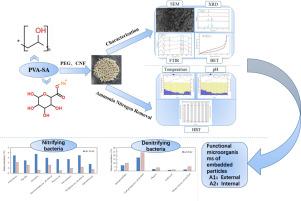氨氮废水中强化纤维素纳米纤维/聚乙二醇包埋颗粒的协同效应:深入的微生物反硝化分析
IF 6.3
2区 工程技术
Q1 ENGINEERING, CHEMICAL
引用次数: 0
摘要
封装和固定化技术为细菌提供了良好的生长环境,具有很强的保护能力,提高了存活率,并能抵抗不利环境因素的影响。具有聚羟基结构的纤维素纳米纤维(CNF)通过非共价作用力提高了包埋颗粒的弹性、拉伸性能、机械强度和凝胶强度。聚乙二醇(PEG)是一种以独特的碳氧链为核心骨架的水溶性聚合物。每个单元中的醚键使 PEG 具有极强的亲水性和溶解性。采用 CNF 和 PEG 加固 SA(海藻酸钠)和 PVA(聚乙烯醇)-SA 包埋颗粒处理氨氮废水。CNF/PEG/SA 和 CNF/PEG/PVA-SA 的氨扩散系数和氧扩散系数分别为 0.454 × 10-9、0.286 × 10-9、0.672 × 10-9 和 0.493 × 10-9 m2/s。通过传质表征、扫描电镜、XRD、傅立叶变换红外光谱和 BET 分析对嵌入颗粒的理化性质进行了表征。CNF/PEG/SA 和 CNF/PEG/PVA-SA 的比表面积分别增加到 2.583 m2/g 和 3.962 m2/g。30 °C 时,CNF/PEG/PVA-SA 系统对 NH4+-N、COD 和 TN 的去除率分别为 90%、74% 和 80%。HRT 8 小时后,增强系统对 NH4+-N、化学需氧量(COD)和总氮(TN)的去除率分别为 94.35 %、63.07 % 和 73.84 %。在中性至弱碱性 pH 值范围内,NH4+-N、COD 和 TN 的去除率最高,分别为 88.51 %、74.95 % 和 77.56 %。半饱和常数 K 为 82.98 mg/L,最大氨氧化率(Vmax)为 358.92 mgN/(L-颗粒-小时)。强化体系的反应动力学为零阶。利用 Michaelis-Menten 方程对各初始 NH4+-N 浓度和氨氧化率进行了非线性拟合。在强化的嵌入颗粒中,进行了微生物基因组数据(KEGG;MetaCyc 数据库注释)分析。强化后的系统在强度、比表面积、传质性能、抵御不利外部环境因素的能力和微生物存活率等方面都得到了增强,可有效处理 NH4+-N 废水。本文章由计算机程序翻译,如有差异,请以英文原文为准。

Synergistic effect of reinforced cellulose nanofibrils/polyethylene glycol embedded particles in ammonia nitrogen wastewater: An in-depth microbial denitrification analysis
The encapsulation and immobilization technology provide a good growth environment for bacteria, strong protection ability, improved survival rate, and resistance to adverse environmental factors. Cellulose nanofibrils (CNF) with polyhydroxyl structure improve the elasticity, tensile properties, mechanical strength and gel strength of embedded particles through non-covalent forces. Polyethylene glycol (PEG) is a water-soluble polymer with unique carbon‑oxygen chain as the core skeleton. The ether bonds present in each unit give PEG extremely strong hydrophilicity and solubility. CNF and PEG to reinforce SA (sodium alginate) and PVA (polyvinyl alcohol)-SA embedded particle were adopted to treat ammonia nitrogen wastewater. The ammonia diffusion coefficients and oxygen diffusion coefficients of the CNF/PEG/SA and CNF/PEG/PVA-SA were 0.454 × 10−9, 0.286 × 10−9, 0.672 × 10−9 and 0.493 × 10−9 m2/s, respectively. The physicochemical properties of embedded particles were characterized by mass transfer characterization, SEM, XRD, FTIR, and BET analysis. The specific surface areas of CNF/PEG/SA and CNF/PEG/PVA-SA increased to 2.583 m2/g and 3.962 m2/g, respectively. The removal efficiency of NH4+-N, COD and TN in the CNF/PEG/PVA-SA system was 90 %, 74 % and 80 % at 30 °C. By HRT 8 h, the removal efficiency of NH4+-N, chemical oxygen demand (COD)and total nitrogen (TN) by the reinforced system was 94.35 %, 63.07 % and 73.84 %, respectively. The neutral to weakly alkaline pH range showed the highest removal efficiencies of NH4+-N, COD, and TN, at 88.51 %, 74.95 %, and 77.56 %, respectively. The half-saturation constant K was 82.98 mg/L, and the maximum ammonia oxidation rate (Vmax) was 358.92 mgN/(L-particles-h). The reinforced system showed zero-order reaction kinetics. Nonlinear fitting of each initial NH4+-N concentration and ammonia oxidation rate was carried out using the Michaelis-Menten equation. In reinforced embedded particles, microbial genomic data (KEGG; MetaCyc database annotation) analysis was conducted. The reinforced system demonstrated enhanced strength, specific surface area, mass transfer properties, resistance to adverse external environmental factors, and microbial survival rate for the effective treatment of NH4+-N wastewater.
求助全文
通过发布文献求助,成功后即可免费获取论文全文。
去求助
来源期刊

Journal of water process engineering
Biochemistry, Genetics and Molecular Biology-Biotechnology
CiteScore
10.70
自引率
8.60%
发文量
846
审稿时长
24 days
期刊介绍:
The Journal of Water Process Engineering aims to publish refereed, high-quality research papers with significant novelty and impact in all areas of the engineering of water and wastewater processing . Papers on advanced and novel treatment processes and technologies are particularly welcome. The Journal considers papers in areas such as nanotechnology and biotechnology applications in water, novel oxidation and separation processes, membrane processes (except those for desalination) , catalytic processes for the removal of water contaminants, sustainable processes, water reuse and recycling, water use and wastewater minimization, integrated/hybrid technology, process modeling of water treatment and novel treatment processes. Submissions on the subject of adsorbents, including standard measurements of adsorption kinetics and equilibrium will only be considered if there is a genuine case for novelty and contribution, for example highly novel, sustainable adsorbents and their use: papers on activated carbon-type materials derived from natural matter, or surfactant-modified clays and related minerals, would not fulfil this criterion. The Journal particularly welcomes contributions involving environmentally, economically and socially sustainable technology for water treatment, including those which are energy-efficient, with minimal or no chemical consumption, and capable of water recycling and reuse that minimizes the direct disposal of wastewater to the aquatic environment. Papers that describe novel ideas for solving issues related to water quality and availability are also welcome, as are those that show the transfer of techniques from other disciplines. The Journal will consider papers dealing with processes for various water matrices including drinking water (except desalination), domestic, urban and industrial wastewaters, in addition to their residues. It is expected that the journal will be of particular relevance to chemical and process engineers working in the field. The Journal welcomes Full Text papers, Short Communications, State-of-the-Art Reviews and Letters to Editors and Case Studies
 求助内容:
求助内容: 应助结果提醒方式:
应助结果提醒方式:


